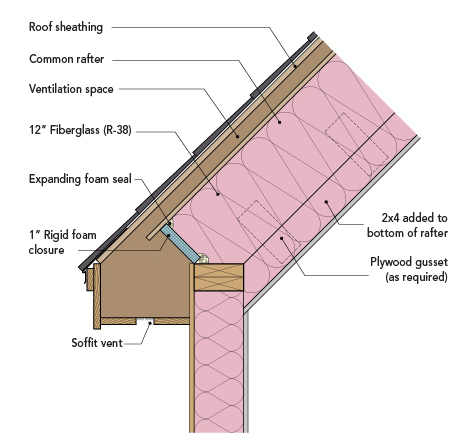Vaulted ceilings add a touch of grandeur to any home, but ensuring proper insulation is essential for comfort and energy efficiency. Delve into the world of “Vaulted Ceiling Insulation Requirements” as we explore the necessary guidelines to enhance your living space. Discover the benefits, materials, and expert recommendations for creating a well-insulated vaulted ceiling that strikes the perfect balance between aesthetics and functionality.

Vaulted Ceiling Insulation Requirements: A Closer Look at the Basics
Understanding the Significance: Why Vaulted Ceiling Insulation Matters
- Energy Efficiency: Beyond Aesthetics Vaulted ceilings contribute to the visual appeal of a home, but without proper insulation, they can lead to significant energy loss. Effective insulation helps maintain a comfortable temperature and reduces heating and cooling costs.
- Temperature Regulation: Year-Round Comfort Insulating a vaulted ceiling ensures consistent indoor temperatures throughout the year. Whether it’s hot summer days or chilly winter nights, proper insulation helps regulate the temperature, creating a comfortable living environment.
- Condensation Prevention: Protecting Your Home Inadequate insulation can lead to condensation issues, potentially causing damage to the ceiling structure and promoting the growth of mold and mildew. Proper insulation acts as a barrier, preventing moisture-related problems.
Meeting the Standards: Vaulted Ceiling Insulation Requirements
In this section, we will outline the essential requirements for insulating a vaulted ceiling, focusing on materials, techniques, and expert recommendations.
Materials for Vaulted Ceiling Insulation: Choosing Wisely
- Fiberglass Insulation:Fiberglass insulation is a popular choice for vaulted ceilings. It comes in batts or rolls and is known for its effectiveness in providing thermal resistance. Proper installation ensures a seamless fit within the vaulted ceiling structure.
- Spray Foam Insulation:For irregular or challenging ceiling structures, spray foam insulation offers a versatile solution. It expands to fill gaps and crevices, creating a continuous barrier against heat transfer. Professional installation is recommended for optimal results.
- Reflective Foil Insulation:Reflective foil insulation, often installed in the roof assembly, reflects radiant heat away from the ceiling. This type of insulation is particularly effective in regions with hot climates, providing a barrier against excessive heat absorption.
Installation Techniques: Ensuring Effectiveness
- Continuous Insulation:Maintaining continuity in insulation is crucial for preventing thermal bridging. Ensure that insulation is continuous and covers the entire vaulted ceiling without gaps or breaks.
- Vapor Barrier Considerations:Depending on climate conditions, the inclusion of a vapor barrier may be necessary to prevent moisture infiltration. Consultation with a professional will help determine the appropriate vapor barrier strategy for your specific circumstances.
- Professional Assessment:Seek the expertise of insulation professionals to assess your vaulted ceiling’s unique requirements. Their insights can guide you in choosing the right materials and techniques tailored to your home’s design.
Expert Recommendations: Creating the Perfectly Insulated Vaulted Ceiling
1. R-Value Guidelines:
The recommended R-value for vaulted ceiling insulation depends on factors such as climate, local building codes, and the presence of additional insulation in the roof. Consult local guidelines or insulation professionals to determine the appropriate R-value for your specific situation.
2. Balanced Ventilation:
Proper ventilation is essential to prevent moisture buildup in the insulated space. Incorporate balanced ventilation systems to ensure a healthy and moisture-free environment within the vaulted ceiling.
3. Regular Maintenance:
Periodic inspection and maintenance of the vaulted ceiling insulation are crucial for its long-term effectiveness. Check for signs of wear, damage, or settling, and address any issues promptly to preserve the insulation’s performance.
Conclusion: Elevating Comfort and Efficiency with Vaulted Ceiling Insulation
Vaulted ceilings can be a stunning architectural feature, but their insulation requirements are critical for achieving a harmonious blend of aesthetics and functionality. By understanding the essentials of “Vaulted Ceiling Insulation Requirements,” homeowners can create spaces that not only captivate the eye but also provide year-round comfort and energy efficiency.
Investing in quality insulation materials, following recommended installation techniques, and seeking professional guidance are key steps in ensuring your vaulted ceiling becomes a testament to both style and sustainability. Make the most of your architectural masterpiece by embracing the art and science of vaulted ceiling insulation.
Read too: Understanding Asbestos in Ceiling Plaster and Ensuring a Safe Home: Unveiling the Dangers